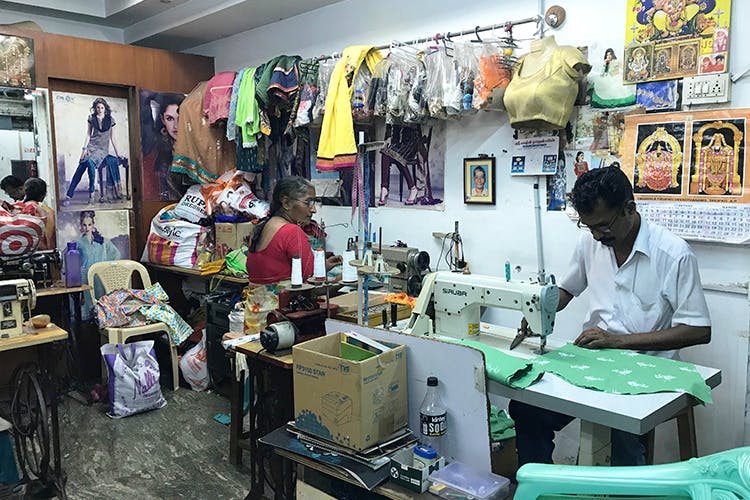Change Your Look with Tailor Perth: Personalized Tailoring Services
Understanding the Tailoring Refine: From Fabric Option to Final Suitable for the Suitable Closet
The tailoring process is a complicated interaction of art and scientific research, starting with the important decision of material selection and finishing in the accurate modifications of last fittings. Each material kind brings distinct high qualities that influence not just the visual allure but also the garment's long life and suitability for different events. Recognizing the nuances of customizing methods can elevate one's closet to unmatched degrees of class. As we check out these elements even more, one need to think about just how even the smallest information can considerably influence the total outcome of one's personal design.
Significance of Textile Option
Selecting the ideal material is vital in the tailoring process, as it directly influences the convenience, toughness, and total aesthetic of the final garment (tailor perth). The selection of textile establishes the foundation for the garment's efficiency, style, and performance. Different materials possess unique residential or commercial properties, such as weight, stretch, and breathability, which can significantly impact how the garment drapes and fits the body
In addition, textile choice affects the garment's longevity and convenience of treatment. Top quality textiles can endure damage, keeping their appearance and framework in time, while lower-quality materials might result in pilling or fading. In addition, the ideal material contributes to the garment's capability to change across periods and celebrations, thereby boosting versatility.
A customized item made from a proper material not just showcases workmanship but also boosts the user's confidence. Subsequently, recognizing the nuances of material choice is extremely important for any kind of tailoring venture. It ensures that the last item not just fulfills the visual needs of the client but likewise straightens with functional demands, therefore achieving a harmonious equilibrium between kind and function in the tailored wardrobe.
Kinds Of Fabrics and Their Uses
Recognizing the different kinds of textiles readily available is vital for making informed choices throughout the tailoring process. Each textile has distinct characteristics that dictate its viability for particular garments and celebrations.
Its flexibility enables it to be customized into every little thing from t-shirts to outfits. Its all-natural elasticity aids garments maintain shape over time.
Silk radiates luxury and is light-weight, making it best for eveningwear and fragile shirts; nevertheless, it calls for cautious handling due to its delicacy. Linen, with its textured surface, is a prominent option for cozy climates, supplying a airy and crisp feel, but it wrinkles easily, which may affect the garment's appearance.
Artificial materials, such as polyester and nylon, deal longevity and resistance to creases, making them appropriate for day-to-day wear and energetic clothing. Recognizing these material types and their residential properties enables for far better decision-making, guaranteeing that each tailored item not just fits well however also aligns with the intended function and event.
The Tailoring Methods Described
The art of customizing depends on a range of methods that change fabric into well-fitted garments. Central to this procedure is pattern preparing, where a tailor creates design templates based on the client's dimensions and wanted style. This first step ensures that the garment will fit the wearer effectively before any type of cutting takes place.
As soon as patterns are established, cutting techniques enter play. Precision is extremely important as inaccuracies can lead to misfitting garments. Tailors frequently use numerous reducing approaches, such as single-layer cutting for elaborate styles and multiple-layer reducing for efficiency on typical patterns.
Basting is an additional crucial technique, permitting tailors to briefly stitch material assemble for an initial fitting. This method uses the possibility to examine the drape and general silhouette before last stitching.
Seaming strategies, consisting of flat-felled joints and French seams, boost the garment's sturdiness and visual charm. Tailors also utilize methods such as interfacing and extra padding to provide structure and shape to specific locations, like shoulders and collars.
Last but not least, completing strategies, consisting of hemming and edge finishing, make certain the garment's long life while providing a refined look. Together, these methods form the backbone of effective customizing, leading to elegant, tailor-made clothing.
Fitting Modifications and Considerations

Key factors to consider include the shoulder fit, which should neither droop nor restrict activity, and the sleeve length, which need to permit comfy arm motion while keeping a sleek appearance. Furthermore, modifications at the waist can improve the silhouette, with alternatives to allow out or absorb fabric as required.
The surge of trousers is another critical factor; it should rest pleasantly above the hips without creating pain, enabling simplicity of movement. Hemming sizes for both pants and skirts must mirror the wearer's preferred style while valuing percentages.

Preserving Your Tailored Garments
Constantly adhere to the treatment tag instructions, which may advise dry cleaning for delicate materials or equipment washing for more sturdy materials. Prevent constant laundering, as this can wear down the textile and modify the garment's form.
Storage is just as go to this site essential; use padded hangers for coats and layers to keep shoulder structure, and store pants folded up neatly or hung to prevent creasing. Secure garments from straight sunshine, which can discolor colors and damage fibers.
In addition, periodic examinations for minor repairs can prevent larger problems. Examine for loose buttons, fraying seams, or signs of moth damages, addressing these issues without delay to preserve the garment's integrity.
Last but not least, you could try this out consider seasonal rotation. Using tailored items in moderation enables textiles to recover, prolonging their life-span. By applying these maintenance methods, you can ensure that your customized garments continue to be as pristine as the day you first used them, enhancing your suitable wardrobe for several years to find.
Verdict
The tailoring process, incorporating fabric selection, knowledgeable strategies, and exact suitable adjustments, plays a crucial function in developing garments that boost both comfort and design. Recognizing the value of upkeep extends the life of customized garments, strengthening their worth in a well-curated closet.
Picking the ideal fabric is vital in the customizing process, as it straight affects the comfort, sturdiness, and general visual of the last garment. The option of fabric establishes the foundation for the garment's style, functionality, and efficiency. Different textiles have special residential or commercial properties, such as breathability, weight, and stretch, which can substantially impact click for more info just how the garment drapes and fits the body.
The art of customizing depends on a range of techniques that transform material into well-fitted garments.The customizing process, encompassing fabric option, proficient strategies, and precise suitable changes, plays a crucial function in developing garments that enhance both comfort and design.